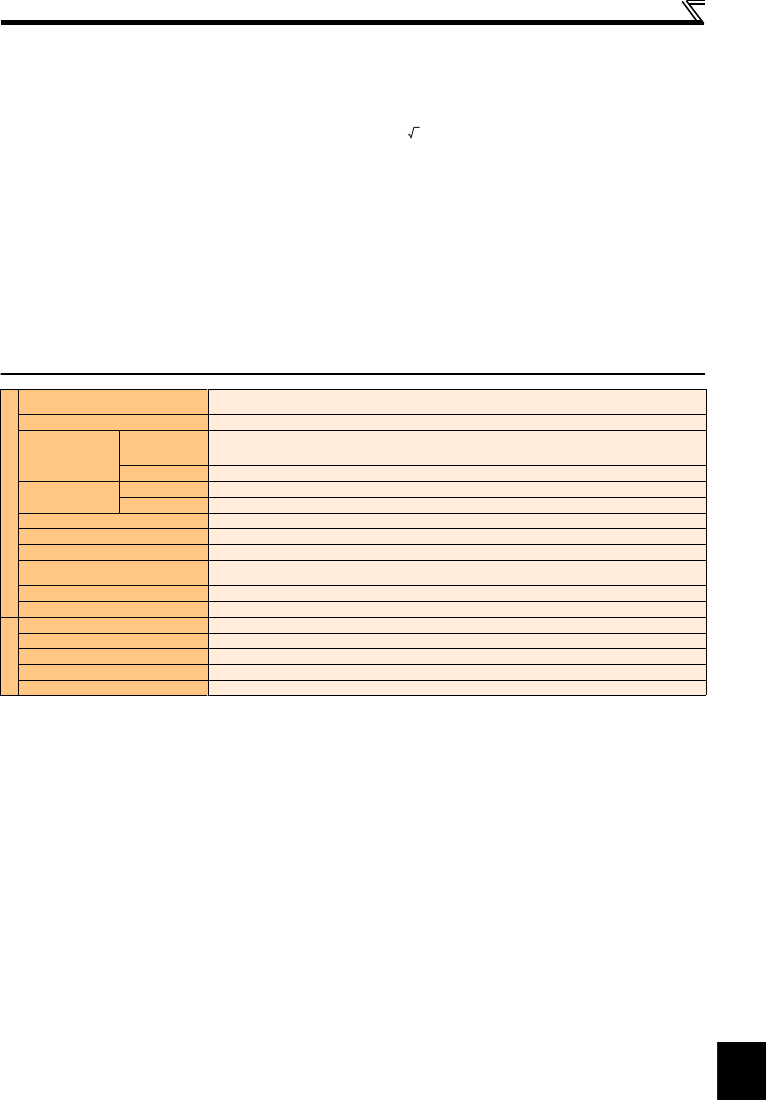
47
Common specifications
10
The applicable motor capacity indicated is the maximum capacity applicable for use of the Mitsubishi 4-pole standard motor.
The rated output capacity assumes the following output voltages: 230V for three-phase 200V/single-phase 200V, and 440V for three-phase 400V.
The % value of the overload current rating indicated is the ratio of the overload current to the inverter's rated output current. For repeated duty, allow time for
the inverter and motor to return to or below the temperatures under 100% load. In a single-phase 200V class inverter with the automatic restart after the
instantaneous power failure (Pr.57) and the power failure stop (Pr.261) functions are set valid, a voltage drop at the power supply and a large load may bring
down the bus voltage to the level recognized as a power failure, disabling the inverter to drive a load 100% or higher.
The maximum output voltage does not exceed the power supply voltage. The maximum output voltage can be changed within the setting range. However,
the pulse voltage value of the inverter output side voltage remains unchanged at about that of the power supply.
The braking torque indicated is a short-duration average torque (which varies with motor loss) when the motor alone is decelerated from 60Hz in the shortest
time and is not a continuous regenerative torque. When the motor is decelerated from the frequency higher than the base frequency, the average
deceleration torque will reduce. Since the inverter does not contain a brake resistor, use the optional brake resistor when regenerative energy is large. A
brake unit (FR-BU2) may also be used. (Option brake resistor cannot be used for 0.1K and 0.2K.)
The power supply capacity varies with the value of the power supply side inverter impedance (including those of the input reactor and cables).
Setting 2kHz or more in Pr. 72 PWM frequency selection to perform low acoustic noise operation with the surrounding air temperature exceeding 40°C, the
rated output current is the value in parenthesis.
Connect DC power supply to terminal P/+ and N/-. Connect the plus side of the power supply to terminal P/+ and minus side to terminal N/-.
Since the voltage between P/+ and N/- may increase due to the regeneration energy from the motor and exceeds 415V temporarily, select the DC power
supply which can withstand the voltage/energy during regeneration. If using the power supply which can not withstand voltage/energy during regeneration,
insert diodes in series for reverse current prevention.
Although the FR-E700 series has the built-in inrush current limit circuit, select the DC power supply considering the inrush current at powering ON as the
inrush current four times of the rated inverter flows at powering ON.
Since the power supply capacity depends on the output impedance of the power, select the power supply capacity which has enough allowance according
to the AC power supply system capacity.
10.2 Common specifications
Control specifications
Control method
Soft-PWM control/high carrier frequency PWM control (V/F control, Advanced magnetic flux vector control,
General-purpose magnetic flux vector control, Optimum excitation control are available)
Output frequency range 0.2 to 400Hz
Frequency setting
resolution
Analog input
0.06Hz/60Hz (terminal2, 4: 0 to 10V/10-bit)
0.12Hz/60Hz (terminal2, 4: 0 to 5V/9-bit)
0.06Hz/60Hz (terminal4: 0 to 20mA/10-bit)
Digital input
0.01Hz
Frequency
accuracy
Analog input
Within 0.5% of the max. output frequency (25°C 10°C)
Digital input Within 0.01% of the set output frequency
Voltage/frequency characteristics
Base frequency can be set from 0 to 400Hz, Constant-torque/variable torque pattern can be selected
Starting torque
200% or more (at 0.5Hz)...when Advanced magnetic flux vector control is set (3.7K or lower)
Torque boost Manual torque boost
Acceleration/deceleration time setting
0.01 to 360s, 0.1 to 3600s (acceleration and deceleration can be set individually), linear or S-pattern acceleration/
deceleration modes are available.
DC injection brake Operation frequency (0 to 120Hz), operation time (0 to 10s), operation voltage (0 to 30%) can be changed.
Stall prevention operation level
Operation current level can be set (0 to 200% adjustable), whether to use the function or not can be selected
Environment
Surrounding air temperature
-10°C to +50°C (non-freezing)
Ambient humidity 90%RH or less (non-condensing)
Storage temperature
-20°C to +65°C
Atmosphere
Indoors (without corrosive gas, flammable gas, oil mist, dust and dirt etc.)
Altitude/vibration Maximum 1000m above sea level, 5.9m/s
2
or less at 10 to 55Hz (directions of X, Y, Z axes)
When using the inverters at the surrounding air temperature of 40°C or less, the inverters can be installed closely attached (0cm clearance).
Temperatures applicable for a short time, e.g. in transit.
2


















